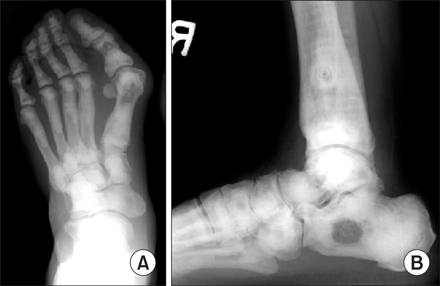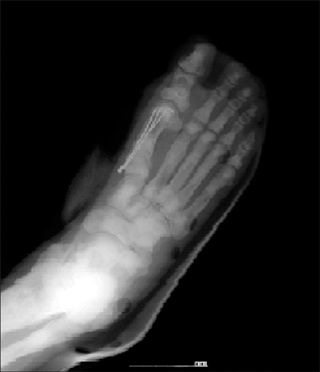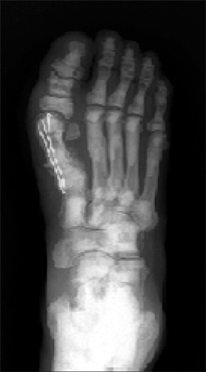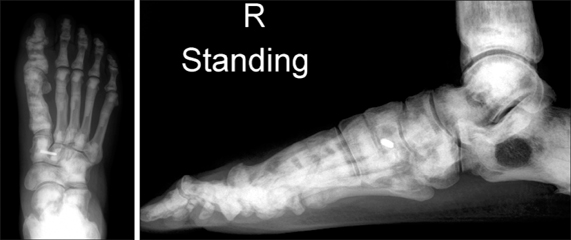J Korean Orthop Assoc.
2008 Dec;43(6):808-812.
Triple Osteotomy for Hallux Valgus in Patient with Osteopetrosis: A Case Report
- Affiliations
-
- 1Department of Orthopedic Surgery, Myongji Hospital, Kwandong University College of Medicine, Goyang, Korea. bladeplate@hanmail.net
Abstract
- Osteopetrosis is a very rare hereditary musculoskeletal disorder with an unknown cause. There are few reports on this condition with most focusing on long bone fractures. Most patients with osteopetrosis require non-surgical treatment and surgery is technically difficult. Hallux valgus deformities in patients with osteopetrosis are always severe and there are no reports on its treatment. We treated a hallux valgus deformity using triple osteotomy method and experienced nonunion, subluxation of the first metatarsophalangeal joint and screw breakage. This is the first report of the surgical treatment of such a case in Korea. We report this case with a review of the relevant literature.
Keyword
MeSH Terms
Figure
Reference
-
1. Albers-Schonberg H. Roentgenbilder einer seltenen Knochener-Krankung. Munchen Med Wchnschr. 1904. 51:365.2. Chahabra A, Westlund LA, Kline AJ, McLaughlin R. Management of proximal femoral shaft fractures in osteopetrosis: a case series using internal fixation. Orthopedics. 2005. 28:587–592.
Article3. Choi WS, Im JI, Kim BH. Open reduction & internal fixation of long bone fracture in osteopetrosis patient. J Korean Fracture Soc. 1995. 8:407–412.4. Kim ID, Lee SY, Ihin JC, Paik YH. A familial osteopetrosis. J Korean Orthop Assoc. 1976. 11:483–488.
Article5. Kleinberg S. Osteopetrosis. Am J Surg. 1954. 87:50–62.
Article6. Milgram JW, Jasty M. Osteopetrosis. A morphological study of twenty-one cases. J Bone Joint Surg Am. 1982. 64:912–929.
Article7. Mitchell DC. Fractures in brittle bone diseases. Orthop Clin North Am. 1972. 3:787–792.
Article8. Montgomery RD, Standard KL. Albers-Schonberg's disease. A changing concept. J Bone Joint Surg Br. 1960. 42:303–312.9. Tachdjian MO. Pediatric Orthopedics. 1990. 2nd ed. Philadelphia: WB Saunders Co;112–115.10. Yune SH, Rhee KJ, Ahn SR, Kim HY. Osteopetrosis. J Korean Orthop Assoc. 1981. 16:467–470.
Article
- Full Text Links
- Actions
-
Cited
- CITED
-
- Close
- Share
- Similar articles
-
- Corrective Osteotomies in Hallux Valgus
- The Effect of Derotational Closing Wedge Akin Osteotomy for the Treatment of Hallux Valgus with the Pronation of Great Toe
- Minimally Invasive Proximal Transverse Metatarsal Osteotomy Followed by Intramedullary Plate Fixation for Hallux Valgus Deformity: A Case Report
- Minimally Invasive Surgery for Hallux Valgus Deformity Using Intramedullary Low Profile Plate Fixation: A Case Report
- The Results of Triple Osteotomy in Adult Hallux Valgus Patients with Highly Increased Distal Metatarsal Articular Angle







